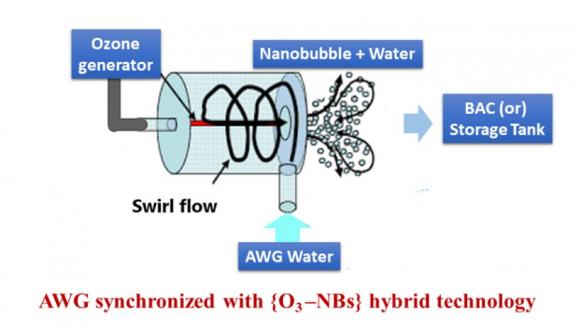Chemical-free ozone integrated nanobubble for disinfection and to enhance the removal of VOCs in produced water from AWGs
Aim: Develop a point of use (PoU) innovative approach to synchronize atmospheric water generators (AWGs) with ozone integrated nanobubbles (O3-NB) based hybrid technology to mineralize the volatile organic compounds (VOCs) and enable disinfectant that persists in produced water from highly polluted atmospheric air (Highly polluted cities).
Objectives/challenges to overcome:
* Generate energy-efficient, cost-effective, and accessible nanobubbles by ultrasonic cavitation or external electric field.
* Synchronize AWG with an ozone-nanobubble system with a physicochemical engineering perspective.
* Investigation and designing the biochemical process while underpinning O3-NB science.
* Mechanistic approach and understand the fate of persistent organic pollutants (POPs) in synergetic effect with ozone and nanobubbles.
Significance of Hybrid {O3-NBs} approach: Using nanobubbles as an ozone delivery mechanism proved increased retention time in the water, the increased surface area of bubbles increasing the contact area, increasing solubility due to high mass transfer area, and reducing the decomposition of ozone in water.
Hybrid {O3-NBs} as aerosol droplet spray module: Ozone nanobubbles, which can also be delivered as an aerosol droplet spray module, a more feasible and economical method to ozonate, sterilize or disinfect properties in agriculture sectors (i.e., crop irrigation), aquaculture, horticulture. These ozone nanobubbles can also be mixed in bulk household water tanks to eliminate common bacteria and viruses. These ozone nanobubbles may function as ‘lifeguard to replenish solvated-ozone levels continually for hours, and their gradual shrinking and exhaustion over these much longer timescales. Therefore this “ozone gas propelled nano-bubbly” water promises to be chemical-free potent oxidation technology, effective than conventional chlorine-based disinfectant.
Outcome: The techno-economical approach integrating {O3-NBs} hybrid technology to remove VOCs and disinfect bio-organism present in produced water from AWGs. Secondly, to boost the ability to store gas directly in aqueous solutions over months. In addition, it can boost several-fold dissolved-gas levels, resulting in greater capacities to treat produced water and enhance mass transfer.


